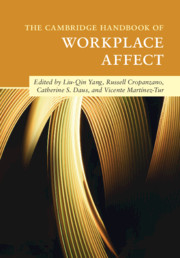Book contents
- The Cambridge Handbook of Workplace Affect
- The Cambridge Handbook of Workplace Affect
- Copyright page
- Contents
- Figures
- Tables
- Contributors
- Foreword
- Part I Theoretical and Methodological Foundations
- Part II Workplace Affect and Individual Worker Outcomes
- Part III Workplace Affect and Interpersonal and Team-Level Processes
- Part IV Workplace Affect and Organizational, Social, and Cultural Processes
- 24 Organizational Entry and Workplace Affect
- 25 Performance Management and Workplace Affect
- 26 Feeling the Heat
- 27 Gender and Workplace Affect
- 28 Affective Climate and Organization-Level Emotion Management
- Part V Discrete Emotions at Work
- Part VI New Perspectives on Workplace Affect
- Index
- References
25 - Performance Management and Workplace Affect
from Part IV - Workplace Affect and Organizational, Social, and Cultural Processes
Published online by Cambridge University Press: 25 June 2020
- The Cambridge Handbook of Workplace Affect
- The Cambridge Handbook of Workplace Affect
- Copyright page
- Contents
- Figures
- Tables
- Contributors
- Foreword
- Part I Theoretical and Methodological Foundations
- Part II Workplace Affect and Individual Worker Outcomes
- Part III Workplace Affect and Interpersonal and Team-Level Processes
- Part IV Workplace Affect and Organizational, Social, and Cultural Processes
- 24 Organizational Entry and Workplace Affect
- 25 Performance Management and Workplace Affect
- 26 Feeling the Heat
- 27 Gender and Workplace Affect
- 28 Affective Climate and Organization-Level Emotion Management
- Part V Discrete Emotions at Work
- Part VI New Perspectives on Workplace Affect
- Index
- References
Summary
Affect and emotion play a critical role in the lives of humans across many domains such as family, health, and work. In fact, Forgas (1994) proposes that “affect is a pervasive part of the way we see the world” (p. 40). Many scholars have proposed and developed theories and frameworks regarding affect that can be and have been applied to various work domains. Our focus in this chapter is on the role of affect in the performance management (PM) process. In particular, the work of Forgas and colleagues on the affect infusion model (AIM: Forgas & George, 2001; Forgas & Williams, 2016) and of Weiss and Cropanzano on affective events theory (AET: Weiss & Cropanzano, 1996) are helpful in explaining how affect fits into this critical work-related process.
- Type
- Chapter
- Information
- The Cambridge Handbook of Workplace Affect , pp. 338 - 349Publisher: Cambridge University PressPrint publication year: 2020



